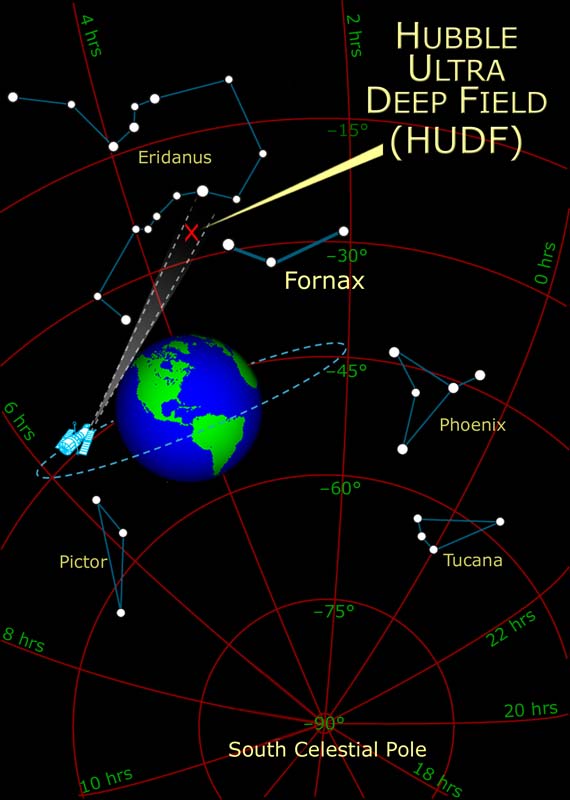
Press Release No.: STScI-2004-07
March 9, 2004
Hubble's Deepest View Ever of the Universe Unveils Earliest Galaxies [Extract]
The HUDF field contains an estimated 10,000 galaxies. In ground-based images, the patch of sky in which the galaxies reside (just one-tenth the diameter of the full Moon) is largely empty. Located in the constellation Fornax, the region is below the constellation Orion.
Installed in 2002 during the last servicing mission to the Hubble telescope, the ACS has twice the field of view and a higher sensitivity than the older workhorse camera, the Wide Field Planetary Camera 2, installed during the 1993 servicing mission. "The large discovery efficiency of the ACS is now being exploited in sky surveys such as the HUDF", Stiavelli says.
Hubble's ACS allows astronomers to see galaxies two to four times fainter than Hubble could view previously, and is also very sensitive to the near-infrared radiation that allows astronomers to pluck out some of the farthest observable galaxies in the universe. This will hold the record as the deepest-ever view of the universe until ESA, together with NASA, launches the James Webb Space Telescope in 2011.
Though ground-based telescopes have, to date, spied objects that existed just 500 million years after the big bang (at a redshift of 10), they need the help of a rare natural zoom lens in space, called a gravitational lens, to see them. However, the ACS can reveal typical galaxies at these great distances. Even much larger ground-based telescopes with adaptive optics cannot reproduce such a view. The ACS picture required a series of exposures taken over the course of 400 Hubble orbits around Earth. This is such a big chunk of the telescope's annual observing time that Institute Director Steven Beckwith used his own Director's Discretionary Time to provide the needed resources.
The HUDF observations began Sept. 24, 2003 and continued through Jan. 16, 2004. The telescope's ACS camera, the size of a phone booth, captured ancient photons of light that began traversing the universe even before Earth existed. Photons of light from the very faintest objects arrived at a trickle of one photon per minute, compared with millions of photons per minute from nearer galaxies.
TIFF and JPEG images, and press release texts are available via World Wide Web at
Hubble's Deepest View Ever of the Universe Unveils Earliest Galaxies
(HubbleSite - NewsCenter. March 9, 2004)
The Space Telescope Science Institute is operated by the Association of Universities for Research in Astronomy, Inc. (AURA), for NASA,
under contract with the Goddard Space Flight Center, Greenbelt, MD.
The Hubble Space Telescope is a project of international cooperation between NASA and the European Space Agency (ESA).
Updated: March 11 '04
Best seen with MS Internet Explorer.
Back: Observatorio ARVAL - Hubble Ultra Deep Field
Messages: